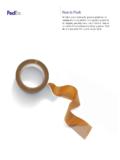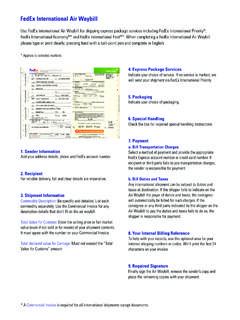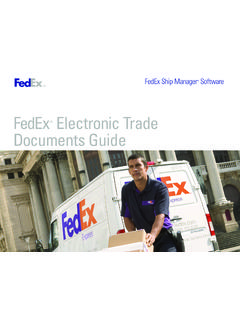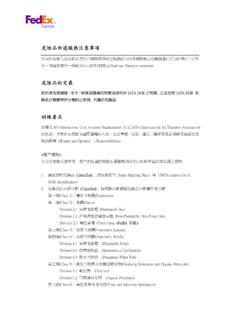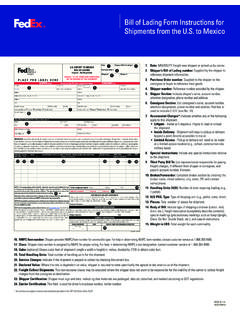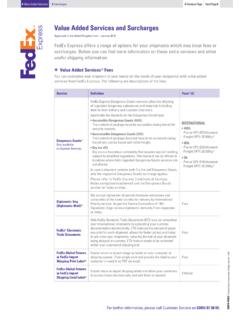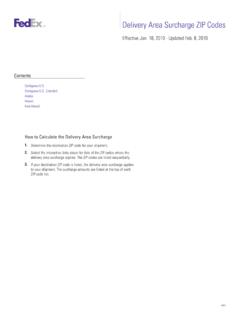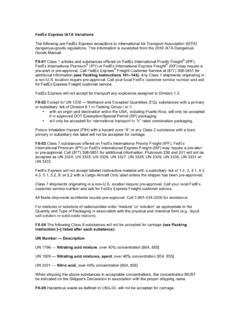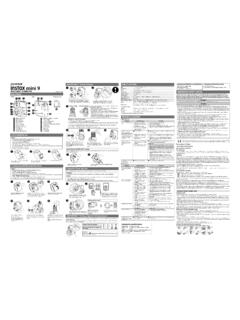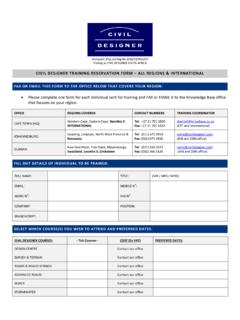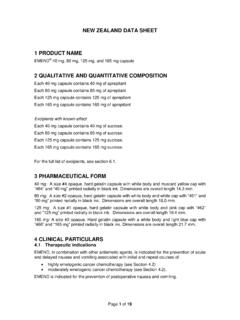Transcription of How to Pack - FedEx
1 How to PackWhether you re looking for general guidelines for packing day-to-day shipments or specific guidelines for shipping specialty items, you ll find it all here in our series of comprehensive packaging guides. Click the one you want. Print just what you need. General Packaging Guidelines 3 Packaging Guidelines for Flowers and Plants 8 Packaging Computer Shipments 12 Packaging Guidelines for Clinical Samples 17 Packaging Guidelines for UN 3373 Shipments 21 Automotive and Mechanical Parts Shipments 25 Packaging Battery Shipments 30 ContentsClick the guide you FedEx , we know proper packaging can help ensure that your shipments arrive safely.
2 So we offer general packaging guidelines from measuring and weighing your package, to packing methods, sealing and labelling instructions, and guidelines for restricted Packaging GuidelinesShipment Size and Weight Restrictions 4 General Packaging Guidelines 4 General Packing Methods 5 Sealing Your Package 6 Addressing and Labelling Your Package 6 Packaging Specialty Shipments 6 ContentsBack to how to pack contentsPage 4 Back to contentsShipment Size and Weight Restrictions With FedEx Express services, you can ship packages up to 68 kg (150 lbs.)
3 ; up to 274 cm (108") in length and 330 cm (130") in length and girth.* With FedEx Express Freight Services, you can ship individual skids of 68 kg (150 lbs.) or more. Skids exceeding 997 kg (2,200 lbs.) in weight or exceeding 178 cm (70") in height, 302 cm (119") in length or 203 cm (80") in width require prior approval.* Dimensions are limited depending on service. Place yellow and black safety heavyweight labels over the diagonal corners of your package if it weighs more than 34 kg (75 lbs.). To get the labels, contact your FedEx Express courier or FedEx account executive.
4 Measuring Length and GirthThe length and girth formula is simple. Here s what you do: Measure the length, height and width of the package. Length and girth equals length plus twice the width and twice the height. Calculating Dimensional WeightDimensional weight applies when your package is relatively light compared with its volume. If the dimensional weight exceeds the actual weight, charges based on the dimensional weight will be assessed. To calculate it: Multiply length by width by height in centimeters, then divide by 5,000 to get the dimensional weight in kilograms.
5 Or multiply length by width by height in inches, then divide by 139 to get the dimensional weight in pounds. Compare the dimensional weight and actual Packaging Guidelines Use FedEx Express packaging for FedEx Express package shipments only; any other use is prohibited. You may use your own packaging if boxes are sturdy and undamaged with all flaps intact. Chipboard boxes, such as gift or shoe boxes, must be packed into a corrugated outer box. Use double-wall boxes for heavier items. Place small packages inside a larger outer box.
6 For express shipments smaller than 18 cm x 10 cm x 5 cm (7" x 4" x 2"), use a FedEx Express packaging option. Double-box fragile items with 8 cm (3") of cushioning in and around the smaller box. Wrap items individually with cushioning material and center them in cartons away from other items and away from the sides, corners, top and bottom of the box. Position bottles that contain liquids upright. Use an inner seal and perforated breakaway cap. The inner packaging must be able to contain leaks. Place items that might be damaged by normal handling, such as soiling, marking or application of adhesive labels, in a protective outer box.
7 For odd- or irregular-shaped items, at a minimum you should wrap and tape all sharp edges or protrusions. Enclose an extra label, business card or letterhead with the shipper s address and phone number and the recipient s address and phone number inside the package before sealing it. Remove all old address labels from reused boxes before shipping, and make sure there are no holes, tears or corner dents in the outer is the longest side of the package or and Girth FormulaGirth is (2 x width) + (2 x height)Page 5 Back to contentsGeneral Packing MethodsFollow these general guidelines for the two most popular packing methods, plus recommendations for odd- or irregular-shaped shipments.
8 Single-Box Packing Method Ship nonfragile products like soft goods inside a sturdy outer box. Use fillers like crumpled newspaper, loosefill peanuts or air-cellular cushioning material to fill void spaces and prevent movement of goods inside the box during shipping. Place goods that might be affected by dirt, water or wet conditions inside a plastic bag. Consolidate small parts or spillable granular products in a strong sealed container, such as a burlap or siftproof plastic bag, then package in a sturdy outer box.
9 Use the H taping method for sealing your Packing Method Wrap product(s) individually with at least 5-cm (2") thickness of air-cellular cushioning or foam material to fit snugly inside a corrugated box. Restrict product movement inside the box using filler like crumpled newspaper, loosefill peanuts or other cushioning material. Close and tape the inner box using the H taping method. This will help prevent accidental opening. Use a second box that is at least 15 cm (6") longer, wider and deeper than the inner box.
10 Choose the wrap or fill method to cushion the inner box inside the larger sturdy outer box. Ship fragile products individually, wrapping them in a minimum 8-cm (3 ) thickness of air-cellular cushioning material such as Bubble Wrap . Wrap the inner box with 8-cm (3") thickness of air- cellular cushioning material or use at least 8 cm (3") of loosefill peanuts or other cushioning material to fill the spaces between the inner box and outer box on the top, bottom and all sides. Fill any void spaces with more cushioning material.
